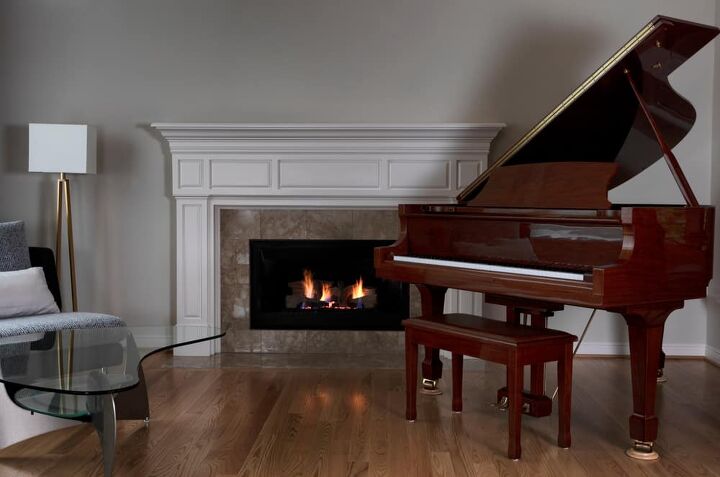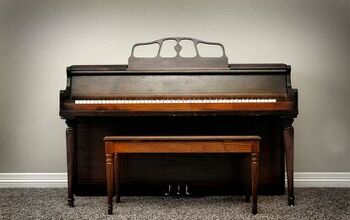Baby Grand Piano Dimensions (with Drawings)

No other musical instrument in the world has that eye-catching, dramatic appeal as a grand piano. You may find it in a concert hall, a hotel ballroom, or even your grandmother’s rarely used parlor. It doesn’t matter whether it’s a baby or a concert grand; a grand piano commands any room it is in.
Being the “baby” of grand pianos, the baby grand is only about 5 feet to 5 feet 7 inches in length. It is usually 5 feet wide and weighs anywhere from 550-700 lbs. Most feature a standard height of 3 feet and 6 inches tall.
There are several types of grand pianos, ranging from the relatively diminutive baby to the impressive concert grand. The major difference in the size of a grand piano is the length of its body. The longer the piano, the longer its keys, the fuller and more forceful the sound it produces.
Types of Grand Pianos
Here are the most common types of grand pianos and their main differences.
Petite Grand Piano
The smallest of the grand pianos is aptly called the petit, or petite, grand. This striking little piano is often lumped together in the same category as the baby grand. The petite grand piano measures about 4 feet and 5 inches to 4 feet and 10 inches in length.
Even while being relatively diminutive, this piano has the standard 88 keys and is about 5 feet wide. It weighs anywhere from 400-500 lbs and stands at 40 inches tall.
A petite grand is perfect when you need a piano that requires a light touch. Ideal for children, the petite grand is suitable for compact spaces that require more than an upright piano.
Baby Grand Piano
The baby grand piano is one you will usually find in many stately homes and boutique hotel lobbies. A typical baby grand piano is 5 feet to 5 feet 10 inches in length and about 3 feet tall. With the requisite 88 keys, the baby grand measures about 5 feet wide or slightly more.
The baby grand certainly weighs more than the largest of upright pianos. Weighing in at 500-600 lbs, this instrument would require at least 6 strong people to move.
Parlor Grand Piano
The parlor grand piano is the smallest of what is considered the concert grand pianos. It is about 5 feet 9 inches to 6 feet and 9 inches in length. It generally stands at 40-44 inches tall and is approximately 5 feet wide.
You’ll find the parlor grand piano in homes with a larger space, hence the term “parlor.” Piano manufacturers often refer to the parlor grand as the “living room grand.” It is also perfectly adequate for a smaller concert or recital hall.
The parlor grand delivers wonderful sound quality that does not require the physical space a concert grand piano does.
Semi-Concert or Ballroom Grand Piano
Next up is the ballroom grand piano that is 6 feet 6 inches to 7 feet and 5 inches long. Also referred to as the semi-concert grand, you can find these pianos in medium-sized performance halls and fancier hotel lobbies.
The ballroom grand is approximately 5 feet in length and weighs about 900 lbs.
Concert Grand Piano
The largest of all the pianos, the concert grand, is the grandest of them all. It can range anywhere from 7 feet 6 inches to over 9 feet long. The largest concert grand piano on the market today is 9 feet and 6 inches long.
This enormous beast that ironically produces wonderfully light, tinkly sounds weighs anywhere from 950-1,200 lbs. The concert grand has at least 88 keys, but other concert grand pianos boast more than that. The Imperial Concert Grand piano manufactured by world-renowned Bosendorfer has 97 keys.
Concert grand pianos are standard instruments for world-class theaters and performance venues all over the globe. World-renowned pianists and musicians demand nothing less than a concert grand piano for live performances. Not only do you get that full sound with rich overtones, but its impressive visual appeal is thoroughly unmatched.
How to Fit a Baby Grand Piano in a Room
As with any furniture piece, you must determine the room’s size for a grand piano to fit. The general rule of thumb is to have a space that is ten times the length of your grand piano. For example, with a 6-foot long baby grand, you would need a room that is about 12 ft x18 ft.
This size translates to 60 feet, which is 10 times the size of the baby grand. Not only will you have enough room, but there is adequate space for someone to sit and play it. Also, consider the piano bench, which generally measures approximately 30 inches wide and 19 inches high.
How to Place a Grand Piano for Maximum Sound Enjoyment
Aside from the physical space, ensure that you can place the piano at a 45-degree angle from the walls. This placement opens up the lid to the opposite corner of the room. Having another person in the room to listen as you play and move the piano incrementally helps.
Ideally, the bass sound waves should be able to move back and forth between the walls. The treble sounds then simply travel to the center of the room and create balance. When you’ve found the best spot, you should be able to appreciate the evenness of tone and resonance.
Points to Consider When Moving a Piano
There isn’t another piece of furniture that is harder to move than a grand piano. The grand piano’s size matters a lot, but even the petite grand needs much thought before an actual move.
As much as possible, position the instrument first before adding the rest of the furniture and fixtures in the room. The piano should be the focus of the room, regardless of whether that be the formal dining room or den.
Here are a few tips to consider before moving a piano.
Prepare the Area
When moving a piano to its new home, it is best to first prepare the area before the instrument arrives. Clear out a straight and the most direct path ensuring there are no objects in the way. Measure the doorway size to determine if you can move in a grand piano right side up or sideways.
Once you have determined the size of the entryways, cover sharp corners with padding or towels to avoid nicking the piano. You may also want to cover all the piano parts with moving blankets to avoid inevitable scratches from transport.
Check if the flooring is suitable for a piano move. If dealing with carpeting or uneven flooring, lay down a thick plastic sheet. Otherwise, use specialized piano caster cups to avoid scratching hardwood floors.
Disassemble Your Piano
Like any other piece of furniture, you should disassemble a grand piano before a major transport. By doing so, you will significantly reduce the weight of each load, allowing for easier transport. It may be time-consuming having to disassemble, then reassemble a piano, but ultimately, it will be more efficient.
If moving your piano from one room to another, there is no need to disassemble the instrument. Simply check entryways and flooring and prepare both appropriately before moving.
Get Professional Help
You may be mulling over the thought of asking a few friends to come by and help move your piano for you. When dealing with a grand piano, this may not turn out to be the best of ideas. Aside from the enormous weight of the instrument, it also requires especially delicate handling.
Professional movers have the proper tools and equipment to move your piano safely from one place to another. They are insured and can also provide the appropriate means of transport. The cost you will incur hiring professionals would be minimal compared to a ruined grand piano.
Tune the Piano
One of the times you need to tune your piano is after a move. A piano is made up of many intricate and delicate parts and needs adjusting after being physically moved. When it is in its new home, it needs a few days to acclimate to its new surroundings.
Once the instrument has gotten used to the new temperatures and humidity levels, call a professional tuner for an adjustment. This would ensure that your instrument remains in tiptop shape for any planned or spontaneous musical performances.
Related Questions
How much is a grand piano?
Brand new grand pianos range from $7,000 for a basic model to almost $200,000 for a concert grand. The size of the grand piano does not necessarily dictate the cost. Many factors to consider are branding, the materials used, labor costs, and even market fluctuations.If in the market for a grand piano, you may want to check out second-hand instruments from reputable sellers. Used grand pianos typically run from $3,500 to about $40,000. Just like purchasing a used vehicle, bring a professional along with you to inspect the inner workings and mechanisms.
With proper maintenance, will a grand piano last forever?
As with any machine or instrument, a grand piano has a lifespan and cannot last forever. With proper maintenance and care, and without being moved, a grand piano can last you approximately 75 to 100 years. However, even if its purpose has expired due to wear and age, the beauty of a grand piano is unmistakable. A grand piano still exudes a commanding presence despite its sadly untouched and silent keys.
Summing It Up
The physical allure of a grand piano is one that simply cannot be ignored or discounted. Having gloriously beautiful music shimmering out of it makes this piece of furniture a true heirloom for generations of families. One could only hope to be part of such an intimate, yet grand, family legacy.

Stacy Randall is a wife, mother, and freelance writer from NOLA that has always had a love for DIY projects, home organization, and making spaces beautiful. Together with her husband, she has been spending the last several years lovingly renovating her grandparent's former home, making it their own and learning a lot about life along the way.
More by Stacy Randall































